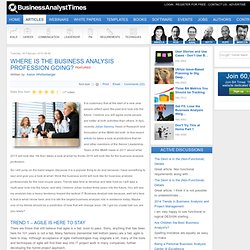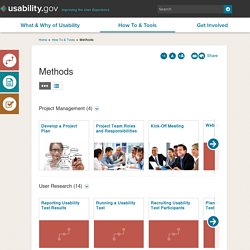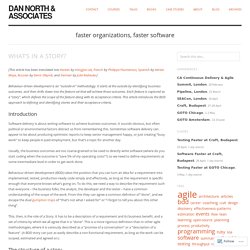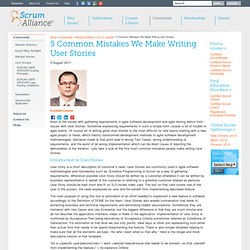

The Minimum Marketable Viable Product Feature Set. There are a few TLA’s (three letter acronyms) used in agile projects to define the scope of a product increment.

So what are they, what do they mean, how do we use them? The following TLA’s are the ones I have seen used recently, there are probably more around. MVP - Minimum Viable Product MMP - Minimum Marketable Product MMF - Minimum Marketable Feature MMR - Minimum Marketable Release I have experienced clients using these TLA’s without understanding the meaning of them and the differences between them, sometimes even using different TLA’s interchangeably. BA Times - Where is the Business Analysis Profession Going? It is customary that at the start of a new year people reflect upon the past and look into the future.

I believe you will agree some people are better at both activities than others. In fact, recently Julian Sammy, Head of Research and Innovation at the IIBA® did both. In this recent article he takes a look at predictions that he and other members of the Senior Leadership Team of the IIBA® made in 2011 about what 2013 will look like. A Digital Experience » Should your Product manager be the Product Owner. In some larger organizations, you may find that these two roles are split.

And although I heavily disagree with this decision, they aren’t technically wrong. Product Owners – Do you OWN your product? « Bring the RIGHT Product to the Market Faster. The Product Owner is responsible for maximizing the value of the product and the work of the Development Team.

How this is done may vary widely across organizations, Scrum Teams, and individuals. The Product Owner is the sole person responsible for managing the Product Backlog. Product Backlog management includes: Create Scenarios. Project Management (4) A project plan takes into account the approach the team will take and helps the team and stakeholders document decisions made regarding the objective, scope, schedule, resources, and...

Creating an interdisciplinary team with the right mix of skills is vital to the smooth and successful execution of any project. Team members may be able to cover multiple roles or there may... Use your kick-off meeting to discuss the business case related to the site, the vision and mission based on user and organizational goals, and the vision for the site moving forward. Website requirements are a list of necessary functions, capabilities, or characteristics related to your website and the plans for creating it.
User Research (14) When reporting results from a usability test, you should focus primarily on your findings and recommendations that are differentiated by levels of severity. Usability Evaluation (14) Use Cases, User Stories and Scenarios - what are they - and how do they relate to TFS 2010. All these three terms are used to describe the behavior of an application.

They come from different process methodologies, and have different meanings, characteristics and are intended to be used differently. Larry Guger also discuss these aspects and several others in his blog entries and The Use Case is the term used in UML and in the different Unified Process based methodologies. See for a good overall description. What’s in a Story? « DanNorth.net. [This article has been translated into Korean by HongJoo Lee, French by Philippe Poumaroux, Spanish by Adrian Moya, Russian by Denis Oleynik, and German by Julia Kadauke.]

Behaviour-driven development is an “outside-in” methodology. It starts at the outside by identifying business outcomes, and then drills down into the feature set that will achieve those outcomes. Each feature is captured as a “story”, which defines the scope of the feature along with its acceptance criteria. This article introduces the BDD approach to defining and identifying stories and their acceptance criteria.
User Stories:Lack of Big Picture Leads to Blind Man Product. An introduction to personas and how to create them » Step Two Designs, Tina Calabria. Written by Tina Calabria, published March 2nd, 2004 Categorised under: articles, intranets, usability & information architecture, websites Before embarking on any intranet or website design project, it is important to understand the needs of your users.

5 Common Mistakes We Make Writing User Stories. Most of the issues with gathering requirements in agile software development and agile testing derive from issues with User Stories.

Somehow expressing requirements in such a simple form causes a lot of trouble to agile teams. Of course art of writing good User Stories is the most difficult for new teams starting with a new agile project or these, which freshly transformed development methods to agile software development methodologies. Mistakes made at that point lead to wrong Test Cases, wrong understanding of requirements, and the worst of all wrong implementation which can be direct cause of rejecting the deliverables of the iteration. Lets take a look at the five most common mistakes people make writing User Stories.
The Easy Way to Writing Good User Stories. Many development shops have opted to writing user stories over traditional feature/requirement documents; however, almost all of them struggle when writing their first batch of user stories.

This is not at all uncommon, just like riding a bike, it does take a little bit of practice (but once you get it – you get it). Writing user stories is dead simple if you follow these simple steps: 1. As a [role], I can [feature] so that [reason] When writing user stories, using this pattern is a for sure bullseye. As a account owner, I can check my balance online so that I can keep a daily balance 24 hours a day. Pretty easy right? User Story Example. I recently described User Stories and the composition of a User Story Card – Card, Conversation and Confirmation.
I’m not really sure if you would consider this user story example to be good, bad or indifferent – I guess it depends what you’re used to – but here is an example nevertheless! Introduction to User Stories. 1. Introduction to User Stories A good way to think about a user story is that it is a reminder to have a conversation with your customer (in XP, project stakeholders are called customers), which is another way to say it's a reminder to do some just-in-time analysis.
In short, user stories are very slim and high-level requirements artifacts. How to write meaningful User Stories - Subcide. I’ve seen a lot of projects fail when by all accounts, they shouldn’t have. The reason for this nearly every time, was that the requirements gathering stage of a project was done poorly, or sometimes not at all. Sometimes this is driven by budget or deadline constraints, and sometimes it’s because the people responsible are just unaware of how to go about gathering requirements in a structured manner, and if you’re one of those people, or know one of those people, then please read on. Requirements exist to make sure that what you think you are building, is the same as what the client or stakeholder thinks you are building. Requirements serve many purposes, but when you strip them down to their core, requirements exist to make sure that what you think you are building, is the same as what the client or stakeholder thinks you are building.
Because of this, they should be as easy to read and understand as possible, which things like functional specification documents usually aren’t. Agile Requirements Definition and Management. One of the myths of Agile software development is that documentation is not required or useful. It is true that one of the core values within the Agile Manifesto is "Working Software over Comprehensive Documentation. " However, note the word "over" in this statement.